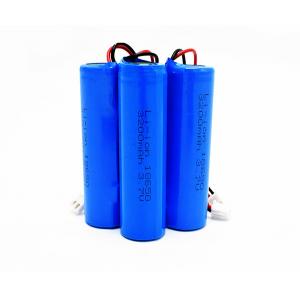

Add to Cart
Buying Li-ion 3200 MAh 3.7V ICR18650 battery with MSDS and UN38.3
Product Parameters:
| Pos. | Product Parameters | Data |
| 1 | Cell dimension | 18±0.5(D) * 65±0.5(H) mm |
| 2 | Nominal capacity | 2200mAh |
| 3 | Minimum Capacity | 2145mAh |
| 4 | Norminal voltage | 3.7V |
| 5 | Standard charging method | 0.5C constant current to 4.2V, constant voltage 4.2V continue charging till current decline to ≤0.01C. |
| 6 | Charge current | 0.5c/1100mAh; 1.0C/2200mAh |
| 7 | Standard discharging method | 0.5C constant current discharge to 3.0V |
| 8 | Operation Temperature and relative humidity Range | Charge: 0~45℃, 60±25%R.H. |
Product performance:
1. The unity of monomer is good. A series of international standard
specifications and models have been established for cylindrical
lithium batteries. The processing technology is relatively mature
and perfect, which is suitable for mass production and
uninterrupted production.
2. Greater than the energy. At present, the actual specific energy
of hyb steel shell battery is 100-135w.h/kg & 280-353w.h/l (2
times of Ni Cd and 1.5 times of Ni MH). With the development of
technology, the specific energy can be as high as 150w.h/kg and 400
& w.h/l.
3. Long service life. The service life of lithium battery is very
long. The cycle life of lithium battery can reach more than 500
times in normal use, which is more than twice that of ordinary
battery.
4. Safety and environmental protection. Lithium batteries do not
contain elements such as cadmium, lead and mercury, which pollute
the environment.
5. There was no memory effect. One of the disadvantages of some Ni
Cd batteries is "memory effect, which seriously restricts the use
of batteries, but lithium batteries do not have this problem.
6. Large capacity. For example, the capacity of 18650 lithium
battery is generally between 1200mAh and 3600mAh, while the
capacity of general battery is only about 800mAh.
Application:
1.Industrial type:
The application fie lds of 18650 lithium batteries are mainly
portable CD players, video recorders, solar energy systems, highway
and railway signal lights, medical devices, portable measuring
instruments, audio devices, electric tools (such asElectric drill,
rotary chisel, electric saw, etc.), cordless telephone,
transceiver, detection and analysis instrument, electronic weighing
instrument, electric model toy, physical detection and numerical
control logging instrument, data acquisition instrument,
communication and command instrument, specialCommunication network
equipment, electronic testing equipment, space equipment.
2.Agricultural type:
18650 the application fields of lithium batteries in agricultural
products mainly include cutting machines, electric pesticide
machines, electric picking machines, bagging machines, loosening
machines, electric sprayers, unmanned water meters, field storage
motors and electric harvester.Cutting machine, electric drill,
electric pump, etc.
3. Civil type:
18650 lithium batteries are widely used in domestic and civil
applications, such as mobile phones, tablets, notebook computers,
electric toys, MP3 / MP4, earphones, chargers, aircraft models,
mobile power supply, flashlight, charging lights, intelligent water
meters,Gas meter, electricity meter, real-time clock, backup memory
power supply, various instruments, instruments, equipment, smoke
alarm and intelligent instrument, remote controller, etc.Lithium
Battery Cell Lithium Battery Cell Model.
Performance Curves of Lithium Cell:
1.Lithium Cell Charge Curve (Charge at 1C)
2. Lithium Cell Discharge Curve (Discharge at 1C )
3. Lithium Cell Cycle Life Curve
How to Extend the Life of Lithium Batteries?
1. Precautions for lithium battery charging:
Lithium batteries are strictly prohibited to be charged from the
discharge terminal, and must be charged from the charging socket
with the matching special charger. When the charging indicator bar
on the charger stops scrolling, please remove the charging plug in
time to avoid overcharging the battery.
2. Notes on discharge:
The lithium battery pack has an overcurrent protection function.
When the use current of the electrical equipment exceeds the
maximum output current of the product, the overcurrent protection
circuit will act and make the electrical equipment appear to be
unable to work normally.
4. Recycling matters needing attention:
The normal cycle of charging and discharging lithium batteries is
about 500 to 800 times, and the lithium batteries at the end of
their life should be recycled and disposed of in accordance with
local laws.
